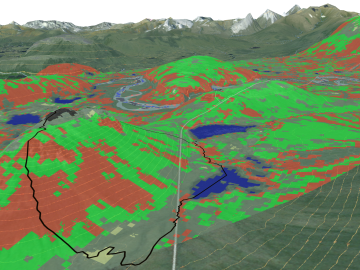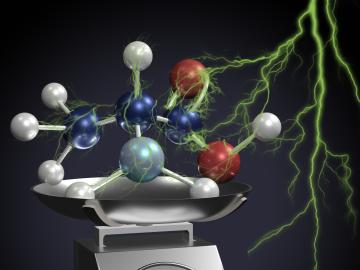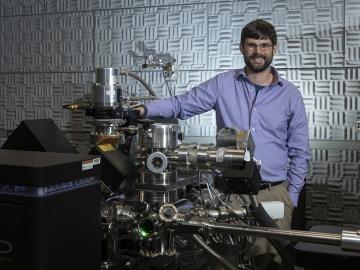
Filter News
Area of Research
- (-) Materials (133)
- (-) Nuclear Science and Technology (7)
- (-) Supercomputing (120)
- Advanced Manufacturing (10)
- Biological Systems (2)
- Biology and Environment (134)
- Biology and Soft Matter (1)
- Building Technologies (2)
- Computational Biology (1)
- Computational Engineering (3)
- Computer Science (16)
- Electricity and Smart Grid (1)
- Energy Frontier Research Centers (1)
- Energy Science (160)
- Energy Sciences (1)
- Functional Materials for Energy (1)
- Fusion and Fission (10)
- Fusion Energy (4)
- Isotope Development and Production (1)
- Isotopes (3)
- Materials Characterization (1)
- Materials for Computing (23)
- Materials Under Extremes (1)
- Mathematics (1)
- National Security (31)
- Neutron Science (45)
- Quantum information Science (8)
- Sensors and Controls (1)
- Transportation Systems (1)
News Topics
- (-) Bioenergy (18)
- (-) Clean Water (3)
- (-) Computer Science (100)
- (-) Environment (36)
- (-) Materials Science (84)
- (-) Nanotechnology (42)
- (-) Polymers (18)
- (-) Security (7)
- 3-D Printing/Advanced Manufacturing (28)
- Advanced Reactors (15)
- Artificial Intelligence (39)
- Big Data (22)
- Biology (14)
- Biomedical (23)
- Biotechnology (2)
- Buildings (8)
- Chemical Sciences (32)
- Composites (9)
- Coronavirus (17)
- Critical Materials (15)
- Cybersecurity (9)
- Energy Storage (37)
- Exascale Computing (26)
- Frontier (32)
- Fusion (16)
- Grid (9)
- High-Performance Computing (45)
- Irradiation (1)
- Isotopes (17)
- ITER (1)
- Machine Learning (15)
- Materials (79)
- Mathematics (2)
- Microscopy (29)
- Molten Salt (7)
- National Security (8)
- Neutron Science (46)
- Nuclear Energy (52)
- Partnerships (11)
- Physics (36)
- Quantum Computing (21)
- Quantum Science (33)
- Simulation (16)
- Software (1)
- Space Exploration (10)
- Summit (43)
- Transportation (19)
Media Contacts
Scientists at the Department of Energy’s Oak Ridge National Laboratory (ORNL) have developed a process that could remove CO2 from coal-burning power plant emissions in a way that is similar to how soda lime works in scuba diving rebreathers. Their research, published January 31 in...

A team of scientists led by Oak Ridge National Laboratory used machine learning methods to generate a high-resolution map of vegetation growing in the remote reaches of the Alaskan tundra.

OAK RIDGE, Tenn., Jan. 31, 2019—A new electron microscopy technique that detects the subtle changes in the weight of proteins at the nanoscale—while keeping the sample intact—could open a new pathway for deeper, more comprehensive studies of the basic building blocks of life.

Jon Poplawsky, a materials scientist at the Department of Energy’s Oak Ridge National Laboratory, develops and links advanced characterization techniques that improve our ability to see and understand atomic-scale features of diverse materials

Scientists at Oak Ridge National Laboratory and Hypres, a digital superconductor company, have tested a novel cryogenic, or low-temperature, memory cell circuit design that may boost memory storage while using less energy in future exascale and quantum computing applications.

Oak Ridge National Laboratory scientists studying fuel cells as a potential alternative to internal combustion engines used sophisticated electron microscopy to investigate the benefits of replacing high-cost platinum with a lower cost, carbon-nitrogen-manganese-based catalyst.

The Department of Energy’s Oak Ridge National Laboratory is collaborating with industry on six new projects focused on advancing commercial nuclear energy technologies that offer potential improvements to current nuclear reactors and move new reactor designs closer to deployment.

Scientists at the Department of Energy’s Oak Ridge National Laboratory have created a recipe for a renewable 3D printing feedstock that could spur a profitable new use for an intractable biorefinery byproduct: lignin.

Carbon fiber composites—lightweight and strong—are great structural materials for automobiles, aircraft and other transportation vehicles. They consist of a polymer matrix, such as epoxy, into which reinforcing carbon fibers have been embedded. Because of differences in the mecha...

Scientists at the Department of Energy’s Oak Ridge National Laboratory used neutrons, isotopes and simulations to “see” the atomic structure of a saturated solution and found evidence supporting one of two competing hypotheses about how ions come


